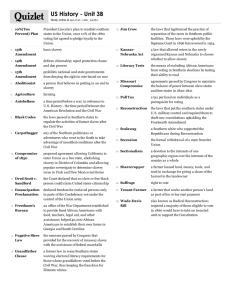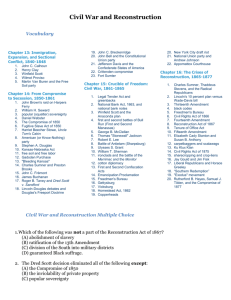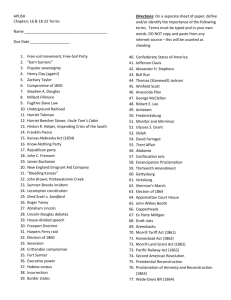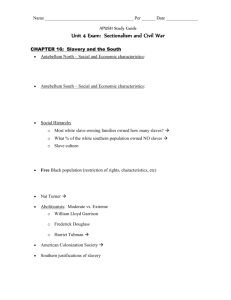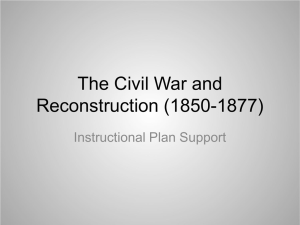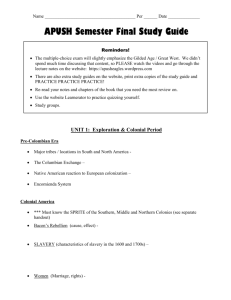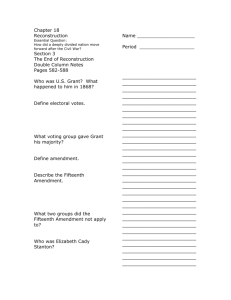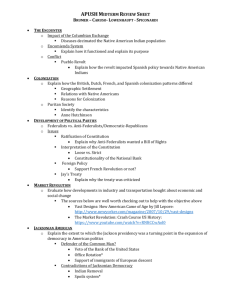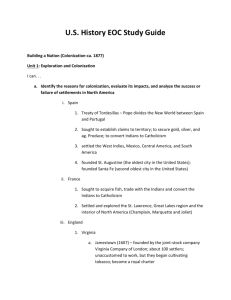APUSH Review 5
advertisement
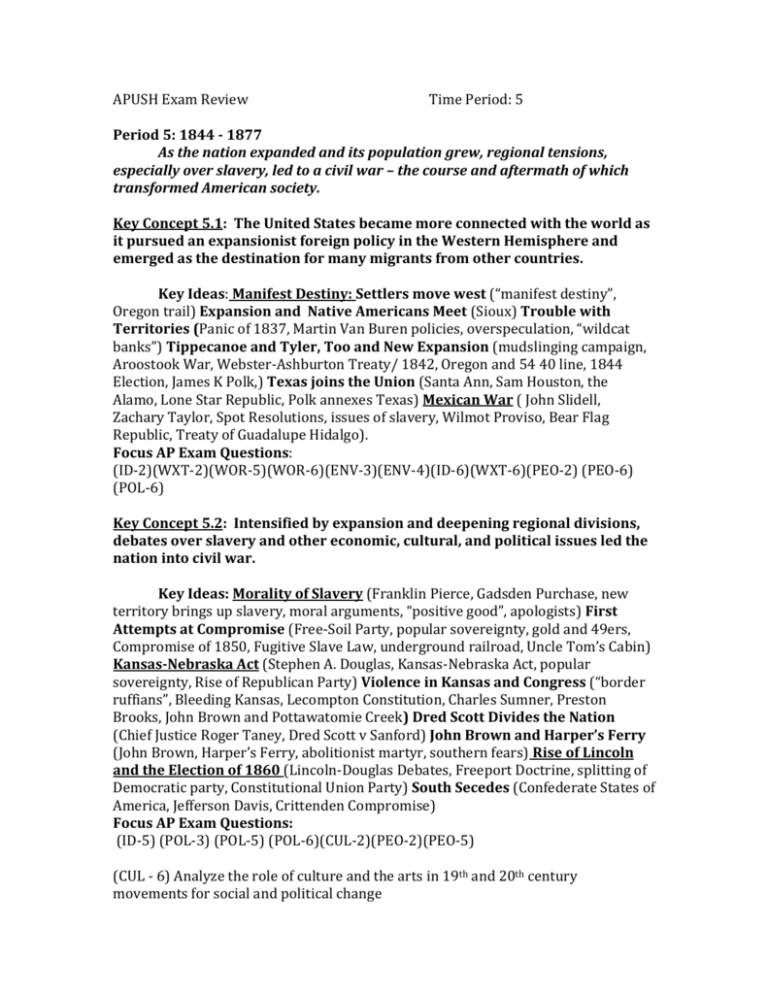
APUSH Exam Review Time Period: 5 Period 5: 1844 - 1877 As the nation expanded and its population grew, regional tensions, especially over slavery, led to a civil war – the course and aftermath of which transformed American society. Key Concept 5.1: The United States became more connected with the world as it pursued an expansionist foreign policy in the Western Hemisphere and emerged as the destination for many migrants from other countries. Key Ideas: Manifest Destiny: Settlers move west (“manifest destiny”, Oregon trail) Expansion and Native Americans Meet (Sioux) Trouble with Territories (Panic of 1837, Martin Van Buren policies, overspeculation, “wildcat banks”) Tippecanoe and Tyler, Too and New Expansion (mudslinging campaign, Aroostook War, Webster-Ashburton Treaty/ 1842, Oregon and 54 40 line, 1844 Election, James K Polk,) Texas joins the Union (Santa Ann, Sam Houston, the Alamo, Lone Star Republic, Polk annexes Texas) Mexican War ( John Slidell, Zachary Taylor, Spot Resolutions, issues of slavery, Wilmot Proviso, Bear Flag Republic, Treaty of Guadalupe Hidalgo). Focus AP Exam Questions: (ID-2)(WXT-2)(WOR-5)(WOR-6)(ENV-3)(ENV-4)(ID-6)(WXT-6)(PEO-2) (PEO-6) (POL-6) Key Concept 5.2: Intensified by expansion and deepening regional divisions, debates over slavery and other economic, cultural, and political issues led the nation into civil war. Key Ideas: Morality of Slavery (Franklin Pierce, Gadsden Purchase, new territory brings up slavery, moral arguments, “positive good”, apologists) First Attempts at Compromise (Free-Soil Party, popular sovereignty, gold and 49ers, Compromise of 1850, Fugitive Slave Law, underground railroad, Uncle Tom’s Cabin) Kansas-Nebraska Act (Stephen A. Douglas, Kansas-Nebraska Act, popular sovereignty, Rise of Republican Party) Violence in Kansas and Congress (“border ruffians”, Bleeding Kansas, Lecompton Constitution, Charles Sumner, Preston Brooks, John Brown and Pottawatomie Creek) Dred Scott Divides the Nation (Chief Justice Roger Taney, Dred Scott v Sanford) John Brown and Harper’s Ferry (John Brown, Harper’s Ferry, abolitionist martyr, southern fears) Rise of Lincoln and the Election of 1860 (Lincoln-Douglas Debates, Freeport Doctrine, splitting of Democratic party, Constitutional Union Party) South Secedes (Confederate States of America, Jefferson Davis, Crittenden Compromise) Focus AP Exam Questions: (ID-5) (POL-3) (POL-5) (POL-6)(CUL-2)(PEO-2)(PEO-5) (CUL - 6) Analyze the role of culture and the arts in 19th and 20th century movements for social and political change Key Concept 5.3: The Union Victory in the Civil War and the contested Reconstruction of the South settled the issues of slavery and secession, but left unresolved many questions about the power of the federal government and citizenship rights. Key Ideas: Two Regions at War: Advantages and Disadvantages of Each Region (Military=South, Population=North, Money=North, Resources=North, agrarian south, industrial north) Finding Soldiers to Fight (desertion, conscription, New York Draft Riots) Dissension in Border States and Congress (keeping borders under control, Copperheads) Military Engagement and Foreign Influence: Union Hatches Plan (Bull Run, Stonewall Jackson, Anaconda Plan, split the confederacy ½, march through Georgia, take Richmond) 2nd Battle of Bull Run and Antietam (Robert E. Lee, Antietam, revolving Union leadership, no foreign help from Britain or France for South, Emancipation Proclamation) Ironclads Enter the War (Merrimac, Monitor, last time US depends on wooden ships) Control of the Mississippi and Gettysburg (U.S Grant, port of New Orleans, Shiloh, Vicksburg, Chancellorsville, Gettysburg) Sherman contributes to Union Victories (march to Georgia, “scorched-earth” policy) Southern Surrender and Assassination (Appomattox Court House, Virginia April 9th 1865, John Wilkes Booth, Lincoln’s Assassination) The End of Slavery and Free Blacks: (Emancipation Proclamation, 13th amendment, freedmen) Social, Political, and Economic Consequences of the War: (loss of life, women got opportunities, southern life changed, increase of presidential power/ writ of habeas corpus suspended, shift from states’ rights to preserving the union, South devastated economically, North industrial boom, West benefitted by expansion, Homestead Act of 1862, Morrill Land Grant Act of 1862, Pacific Railway Act of 1862) Presidential and Radical Reconstruction: Assimilating Former Southern States and Slaves ( Proclamation of Amnesty and Reconstruction/ 10% plan, pardons to former confederates, Wade-Davis Bill/50%, pocket-veto of Wade-Davis by Lincoln, Freedman’s Bureau) Uneasy Rule of Andrew Johnson (10% plan, disenfranchisement of former Confederates, “swing around the circle”, “Waving the Bloody Shirt”, radical republicans, Black Codes, sharecropping) Fourteenth Amendment (Congressional/radical Reconstruction, Civil Rights Bill of 1866/vetoed, 14th Amendment/right’s of all citizens, granted African Americans full citizenship and civil rights) More Troubles for Johnson (Military Reconstruction, Tenure of Office Act, Impeachment) Fifteenth Amendment (15th Amendment – barred any state from abridging a citizen’s right to vote on the basis or race, color, or previous servitude) Dreams, Success, and Realities Southern Governments: (Scalawags, Carpetbaggers, scandals, Credit Mobilier, KKK, Force Acts of 1870 and 1871) Freedmen in the Postwar South: (Exodusters, “forty acres and a mule”, Freedman’s Bureau) Compromise of 1877 (Election of 1876, Rutherford B. Hayes, Samuel Tilden, Compromise of 1877 and withdrawal of federal troops, end of Reconstruction) Impact of Reconstruction Focus AP Exam Questions: (POL-5)(CUL-2)(ENV-3)(POL-6) (ID-5) (ID-2)
